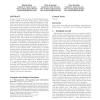Free Online Productivity Tools
i2Speak
i2Symbol
i2OCR
iTex2Img
iWeb2Print
iWeb2Shot
i2Type
iPdf2Split
iPdf2Merge
i2Bopomofo
i2Arabic
i2Style
i2Image
i2PDF
iLatex2Rtf
Sci2ools
SACMAT
2015
ACM
2015
ACM
Mitigating Multi-Tenancy Risks in IaaS Cloud Through Constraints-Driven Virtual Resource Scheduling
A major concern in the adoption of cloud infrastructure-asa-service (IaaS) arises from multi-tenancy, where multiple tenants share the underlying physical infrastructure operated by a cloud service provider. A tenant could be an enterprise in the context of a public cloud or a department within an enterprise in the context of a private cloud. Enabled by virtualization technology, the service provider is able to minimize cost by providing virtualized hardware resources such as virtual machines, virtual storage and virtual networks, as a service to multiple tenants where, for instance, a tenant’s virtual machine may be hosted in the same physical server as that of many other tenants. It is well-known that separation of execution environment provided by the hypervisors that enable virtualization technology has many limitations. In addition to inadvertent misconfigurations, a number of attacks have been demonstrated that allow unauthorized information flow between virtual machines hos...
| Added | 17 Apr 2016 |
| Updated | 17 Apr 2016 |
| Type | Journal |
| Year | 2015 |
| Where | SACMAT |
| Authors | Khalid Zaman Bijon, Ram Krishnan, Ravi S. Sandhu |
Comments (0)

